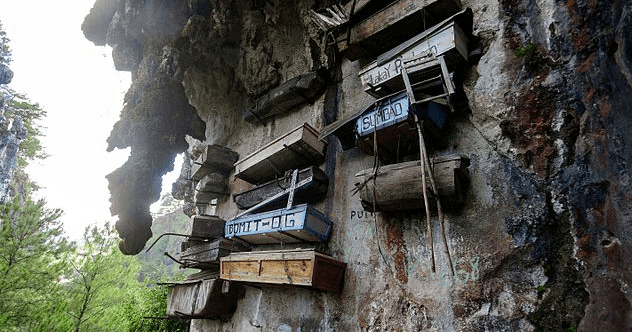Rituals are a fundamental part of human experience, weaving through our daily lives, religious practices, and celebrations. Many traditions are passed down through generations, becoming cherished customs. While history books tell us about common ancient rituals, many more remain shrouded in mystery, waiting to be discovered.
Are you ready to journey back in time and explore some of the most intriguing and lesser-known practices of our ancestors? Let’s delve into ten ancient rituals that you might not know much about, revealing fascinating glimpses into past cultures and beliefs.
1. The Hanging Coffins of Indonesia
In parts of Indonesia, particularly among the Torajan people, an unusual funeral practice involved suspending coffins from cliffs or placing them in caves high above the ground. This practice, also found in parts of China and the Philippines, dates back centuries, with some Chinese examples from the 8th century.
The belief behind this custom was multifaceted. Some thought it kept the deceased closer to the gods, allowing for an easier journey to the heavens. Others believed it protected the bodies from animals and earthly disturbances. For the Torajans, a higher placement was thought to shorten the soul’s journey to Nirvana. While no longer actively practiced, these astonishing hanging coffins remain a striking tourist attraction, offering a chilling yet fascinating insight into ancient burial customs.
2. The Retainer Sacrifice of Ancient Egypt
Ancient Egypt is known for its elaborate funerary rites, but the retainer sacrifice is a particularly dark aspect. This practice involved the ritual killing of servants and officials so they could accompany their ruler into the afterlife. It was most prominent during the First Dynasty of Egypt.
At royal cemeteries like Umm el-Qa’ab, tombs of kings such as Aha were surrounded by subsidiary graves containing these retainers. The layout of these graves often reflected the status and relationship of the servants to their master. Archaeological findings suggest that many of these individuals were relatively young, around 25 years old. This has led some experts to believe that some retainers may have willingly accepted their fate, perhaps viewing it as an honor or a continuation of their service.
3. The Blood Eagle Death Rite
Allegedly practiced by Vikings, the Blood Eagle is one of history’s most gruesome and ritualized execution methods. Its historical accuracy is debated among scholars, as accounts primarily come from Norse sagas and poetry written centuries after the Viking Age. The descriptions are so brutal that some question if it was physically possible.
The purported ritual involved:
- Cutting the victim’s back and pulling the skin away from the spine.
- Severing the ribs from the backbone and splaying them outwards, resembling wings.
- Pulling out the lungs and draping them over the rib “wings.”
If true, this terrifying act was likely a sacrifice to the gods or a severe form of punishment. Today, the modern iteration of the old Norse religion, Asatru, is entirely peaceful, with no connection to such violent historical interpretations.
4. The Living Ghosts of Benin
In Benin, West Africa, the Egungun are masked, robed figures believed to embody the spirits of ancestors returning to the world of the living. Villagers hold these figures in high regard, believing they offer wisdom, advice, and deliver judgments from the gods.
It is strictly forbidden to touch an Egungun, as it’s believed to result in death for both the Egungun and the person who touched them. To prevent accidental contact, minders with sticks accompany the Egungun, keeping crowds at a safe distance. These “living ghosts” speak in distinctive, high-pitched voices to enhance their otherworldly presence. The Egungun tradition is part of a secretive religious practice, and it’s rumored that these figures still appear in some communities today, continuing to connect the living with the ancestral realm.
5. Thaumogenesis

Thaumogenesis is a more mythical concept, described as a perilous consequence of attempting to resurrect the dead through forbidden magic. According to these beliefs, the process didn’t just bring back a soul; it could also inadvertently summon demonic entities or open portals to other dimensions.
The ritual was thought to create a kind of spiritual imbalance. When a spirit was unnaturally pulled back to the land of the living, a demonic entity might piggyback on this connection, or the portal itself could allow malevolent energies to seep through. In essence, thaumogenesis represented a dire spiritual price for meddling with the natural order of life and death, potentially unleashing a new demon upon the world.
6. Mayan Bloodletting Rituals
Bloodletting was a significant ritual practice across many Mesoamerican cultures, including the Maya. It was seen as a way to nourish the gods and ensure the continuity of the cosmos. The Mayans believed that blood contained a life force or spiritual energy vital for both humans and deities.
These rituals involved drawing blood by puncturing soft body parts, such as the tongue, ears, or genitals, often using sharp objects like obsidian blades or stingray spines. The collected blood was then typically spattered onto paper and burned, the rising smoke carrying the offering to the gods. Bloodletting was performed during important events like:
- The accession of a new king.
- Dedications of monuments and temples.
- Critical agricultural periods.
- Significant life events for royalty, such as births, deaths, or marriages.
7. The Rituals at Pömmelte
Often called the “German Stonehenge,” the Pömmelte sanctuary is a Bronze Age circular enclosure in Germany. Archaeological investigations have revealed it was a site of significant ritual activity, including sacrifices. Unlike Stonehenge’s massive stone structures, Pömmelte was primarily made of wood and earthen rings.
Excavations uncovered numerous pits containing various offerings and remains. Among the discoveries were the bodies of women and children, some showing signs of violent death, such as skull trauma and rib fractures. These remains were found alongside broken pottery, animal bones, tools, and millstones, suggesting complex ritual practices. While the exact nature of these rituals remains a mystery, the evidence points to Pömmelte being a major ceremonial center where offerings, possibly including human sacrifices, were made to appease unknown deities.
8. The Dionysian Mysteries
The Dionysian Mysteries were secret religious rites celebrated in ancient Greece and later in Rome, dedicated to Dionysus (or Bacchus), the god of wine, ecstasy, and fertility. These rituals were known for their ecstatic and often wild nature, involving music, dance, wine consumption, and trance-inducing techniques.
The aim was to achieve a state of enthousiasmos, or divine possession, allowing participants to transcend their ordinary selves and connect directly with the god. Unusually for the time, these mysteries were often inclusive, welcoming women, slaves, and non-citizens. Because of their secretive nature and unconventional practices, much about the Dionysian Mysteries remains shrouded in speculation, but they clearly played a vital role in the spiritual lives of many ancient people, offering liberation from social constraints.
9. Utagaki
Utagaki was an ancient Japanese Shinto courtship and fertility ritual. Typically held in spring and autumn on mountaintops or other scenic locations, villagers would gather for communal activities. These gatherings involved singing, dancing, feasting, reciting poetry, and, notably, engaging in free sexual intercourse.
This practice was believed to be an offering to local kami (gods or spirits), ensuring fertility for both the people and the land, resulting in bountiful harvests and healthy children. Utagaki also served as an important social occasion for unmarried individuals to meet potential partners. Over time, as Buddhist influences grew in Japan, Utagaki practices were gradually suppressed by authorities who viewed them as unruly. However, elements of these festive gatherings, albeit in less explicit forms, have survived in some local festivals.
10. The Sacred Marriage of the Babylonians
In ancient Mesopotamia, particularly in Babylonia, the Sacred Marriage (or hieros gamos) was a vital religious ritual. It involved a symbolic and often physical union between a human representative and a deity, or two human representatives acting as gods, to ensure fertility and prosperity for the land and its people.
Most famously, this ritual re-enacted the marriage between the goddess Inanna (Ishtar) and the shepherd god Dumuzi (Tammuz). The king or a high priest would typically take on the role of Dumuzi, engaging in sexual intercourse with a priestess representing Inanna. This union was believed to renew the cosmic order, guarantee agricultural abundance, and bless the community. It’s important to note that this ritual was distinct from ordinary marriage, serving a specific religious and societal purpose to harness divine energy for communal benefit.
Conclusion
These ten ancient rituals offer a fascinating window into the diverse beliefs and practices of past civilizations. From honoring the dead in unique ways to seeking divine favor through ecstatic communion or symbolic marriage, these customs highlight humanity’s enduring quest for meaning, connection, and control over the unpredictable forces of nature and life. While some may seem strange or even shocking to us today, they were deeply significant to the people who practiced them, shaping their understanding of the world and their place within it. Exploring these lesser-known rituals reminds us of the rich tapestry of human history and the myriad ways cultures have sought to navigate the mysteries of existence.
What do you think about these ancient rituals? Do you know of any other obscure practices? Share your thoughts in the comments below!










